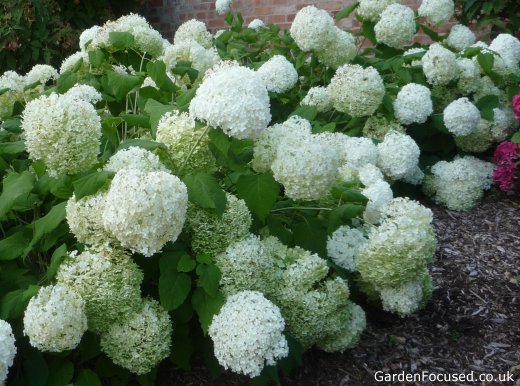BACKGROUND
Hydrangea arborescens was first introduced to the UK by Peter Collinson from Pensylvania in 1736. The variety ‘Annabelle’ was found growing wild in the small village of Anna (hence the name ‘Annabelle’) in Shelby County, Ohio.
APPEARANCE
Hydrangea arborescens ‘Annabelle’ will grow to a height and spread of 2m / 7ft after four or five years. Without a shadow of doubt the main interest of this shrub is the large number of huge white flowers produced from late July to early September. In ideal conditions the flowers can reach 25cm / 10in across.
The downside of those large blooms is that the stems often cannot support them and they do tend droop especially when the shrub is young.
When the flowers first appear they are pure white, turning to a creamy white and then a light lime colour. Both fresh (a short life) and dried flowers are superb for flower arrangements. The leaves are mid green turning yellow as autumn approaches.
Hydrangea arborescens ‘Annabelle’ is not suited to growing in containers.
HOW TO PLANT HYDRANGEA ARBORESCENS ANNABELLE
The soil conditions and the position are key to planting Hydrangea arborescens ‘Annabelle’. Get those correct and planting is simple.
- Choose a free draining soil which receives a good supply of of rainfall.
- Improve poor soils with garden compost and fish, blood and bone fertiliser.
- Neutral to acidic soils are best for your hydrangea, avoid alkaline soils.
- April or mid September to October are the best times to plant hydrangeas. Make sure they are well watered.
- The best position is one which receives sun in the morning and late afternoon.
- Dig a hole twice the width of the rootball. Sprinkle in a handful of blood, fish and bone and work into the ground.
- Place the plant into the hole.
- Fill around the root ball and firm the soil down gently but firmly. Water well to settle the surrounding ground around the root ball.
- Plant to the same depth as your hydrangea was in the pot.
CARE OF HYDRANGEA ARBORESCENS ANNABELLE
To grow the largest flowers it’s essential to grow these shrubs in ideal conditions. They will also grow in less than ideal conditions but the blooms will be smaller. For the ideal conditions, read this section and the section entitled How to Plant Hydrangea Arborescens.
In the first couple of years of its life it is very likely that your Annabelle hydrangea will not be able to support the large flowers. It’s best to support the stems for a couple of years at least until the stems have thickened up. You can either make your own supports or buy a ready made one.
Plant supports come in all sorts of shapes and sizes, we would recommend a peony plant support as the ideal solution. They are readily available in garden centres or online. A good quality, long lasting peony plant support can be found
online here.
Each spring apply a mulch around the plant to lock in moisture and provide a wide range of low level nutrients as the mulch rots down.
Each spring and autumn scatter a couple of handfuls of
fish, blood and bone around the shrub and work it in gently with a trowel.
There are more expensive fertilisers but this one is very cheap and ideal. It provides nutrients over a long period of time and avoids releasing
too much nitrogen. Do not apply a nitrogen rich plant fertiliser, it will
encourage weak stems and foliage at the expense of flowers.
Although this shrub will tolerate drought it will reduce its flowering
ability. It’s best to water the plant well in summer during extended dry
periods or where the soil drains very easily.
HOW TO PRUNE HYDRANGEA ARBORESCENS ‘ANNABELLE’
Follow the steps below to prune your Hydrangea arborescens ‘Annabelle’:
- Prune during mid March in warmer parts of the UK to mid April in
cooler areas. - Prune back stems, which have flowered to a healthy bud about 10cm / 4in below the flower.
- Cut out, as low as possible, any diseased or damaged stems.
- For Annabelle hydrangeas which are four or more years old, cut back a quarter of the stems to 30cm / 12in high
- Feed with two handfuls of fish, blood and bone and apply a mulch as described in the previous section.
WHERE TO BUY HYDRANGEA ARBORESCENS ‘ANNABELLE’
Hydrangea arborescens ‘Annabelle’ is a very common shrub and should be available in very many garden centres. It is also readily available online. From past experience we would recommend Crocus if you want buy this shrub online, see their
page here.
SUMMARY OF HYDRANGEA ARBORESCENS ‘ANNABELLE’
HEIGHT: 2m (7ft) or slightly less
SPREAD: 2m (7ft) or slightly less
FLOWER COLOUR: White to cream then light lime
FRAGRANCE: Minimal
LEAVES: Fleshy mid green
HARDINESS: -15C
DISEASE RESISTANCE: Good.
GROWING CONDITIONS: Partial sunlight (four hours or more sun)
SOIL CONDITIONS: Almost all soil conditions except dry or water-logged soils
CONTAINER GROWING: No
AWARDS: RHS Award of Garden Merit (AGM)
MORE IN DEPTH HYDRANGEA REVIEWS
Click here for more in depth reviews of our recommended Hydrangea varieties.

How To Grow Hydrangeas
Caring for Hydrangeas
Pruning Hydrangeas
Hydrangea Varieties
Growing Hydrangeas in Containers
HYDRANGEA ARBORESCENS ANNABELLE
By David Marks
Hydrangea arborescens ‘Annabelle’ is a North American variety which can withstand very low temperatures, -20C is not a problem. So no winter in the UK will kill it.
Grown in ideal conditions, it can produce white to lime coloured blooms which are 25cm / 10in across, and they can cover the entire shrub.
Awarded an AGM by the Royal Horticultural Society they are comon shrubs in garden centres and online.